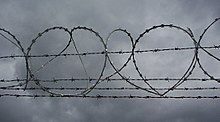有刺铁丝网

有刺鐵絲網(barbed wire),是一種防禦型的金屬絲,身上佈滿尖銳的刃口,刃與刃之間亦有相同的距離。這類絲網價格低廉,用來保護牆內的財產,並是第一次世界大戰裡塹壕戰的重要防守設備。
若一個人或一隻動物經過有刺鐵絲網時,便會遭受到皮膚上的痛楚,嚴重者更會受傷。有刺鐵絲網的製造十分簡單,只需要幾條固定鐵絲網的柵柱,然後再利用例如訂書機的工具,即可完成構造。就算一個不熟練的製造者,也能夠很快完成構造。
在1865年,Louis Jannin發明了有刺鐵絲網。[1]1874年,伊利诺伊州迪卡尔布的Joseph F. Glidden等人改良為更成功的鐵絲網。[2][3]在最早時期使用鐵絲網的目標,是想限制牛和其他牲畜的活動範圍。由於鐵絲網較其他類型的柵欄更容易建造。因此它在19世紀初被美國通行,平民百姓更能大規劃地利用鐵絲網來限制畜牧。
歷史
[编辑]

有一名來自美國伊利諾州DeKalb城Waterrman村的農民,名叫亨利露絲。他發明了一樣利用木塊組成的絲網刃,目的為了防範外來闖入的生畜。他於1873年某一次將自己的發明公開給城裡的縣集市,因此就有幾名市民(Isaac Ellwood, Joseph Glidden and Jacob Haish)將此發明加以改良,於1874年2月份公諸於世。

防人柵欄
[编辑]有刺鐵絲網大都能夠有效地防止生畜逃跑,但对人类来说,只要在攀爬时巧妙地避开铁刺,越過常规有刺鐵絲網并非难事。為了防範人類的前進,一些高度设防的地方例如监狱,就會使用一種特制的鐵絲網——刀片刺網(razor wire)。這種鐵絲網身上每隔數寸就附有尖銳的金屬刺條,在未受保護的情況下足以令一個人受傷。所以,刀片刺網比起其他普通的有刺鐵絲網更難攀越。有时刀片刺網上的刺條更连接電路,攀爬者接触到刺条便会遭到电击,常見於監獄、戰俘營、古拉格等收容設施。在第一次世界大戰期間,這類有刺鐵絲網被用來阻擋敵兵前進,另外更使用它來防範戰俘逃亡。在某些學校的圍牆上也有鐵絲網的設置,除了防盜外還能具體遏止學生逃學。部分的國界上也有鐵絲網的身影,如美墨邊界、柏林圍牆、三十八度線、巴勒斯坦的猶太人屯墾區、馬其諾防線、南北塞浦路斯邊界、南北蘇丹邊界等等。
鐵絲網除了軍事和收容用途外,也用在一些國家的大使館和領事館中防止外來的敵意人士擅闖進入,尤其在兩國外交處於險惡的地區,如美國和以色列的使領館為防恐怖份子和暴民攻擊而在圍牆頂端加裝了鐵絲網。
現今,於世界各地的群體事件、示威、抗議活動中,維持秩序的鎮暴警察會使用一種稱為「蛇籠」的彈簧狀鐵絲網,可從一輛專門的運輸拖車上將蛇籠拉出來以阻絕抗議隊伍的前進。
有刺鐵絲網帶來的傷害
[编辑]
過度地穿越鐵絲網會對皮膚做成一連串的傷害,但最主要都是看接觸的位置來取決。若想穿越有刺鐵絲網而又不被刺傷的話,穿越者必需全神貫注,尤其是注意自己的衣服有否被刺入,方能減少受傷的機會。常常被鐵絲網刺傷的大部份都是那些馬、蝙蝠或鳥類。但馬類最容易驚慌,因為當牠們接觸到鐵絲網時,通常會被刃口撕掉整塊肉,嚴重者更刺入骨內。由於這種功效,有刺鐵絲網經常會被用來對付騎兵。有些馬的傷口能夠痊癒,但有些則導致馬匹的殘廢或死亡。至於鳥類或蝙蝠等飛行動物,因為沒有足夠的能力去觀察出細微的絲網,而被撕傷或刺傷皮膚。因此,在澳大利亞某一年間,就有超過60種野生動物被有刺鐵絲網刺傷至死。野外友好欄杆計劃組織(wildlife friendly fencing)因而被分配工作來解決此問題。
拆除方法
[编辑]在戰場上,工兵會負責拆除鐵絲網的工作,起初工兵使用大剪刀去把鐵絲網剪開來開路,但要把網絲逐條剪開很浪費時間。在第一次世界大戰前,英國軍隊中的印度人兵團就發明了炸藥筒,將裝滿高性能炸藥的鐵筒插進鐵網底下然後將炸藥筒引爆,以爆破出來的破片和衝擊波即時把鐵絲網斬斷和撐開。炸藥筒成為了各國軍隊的工兵清除鐵絲網的兵器並使用至今。
參考資料
[编辑]- ^ first patent in the United States for barbed wire
- ^ The American Experience Technology Timeline: 1752 - 1990. The American Experience. Public Broadcasting Systems. 2000 [2009-01-28]. (原始内容存档于7 February 2009).
- ^ Lucien B. Smith. Ohio History Central. Ohio Historical Society. 31 July 2006 [2009-01-28]. (原始内容存档于2007-10-03).
進一步閱讀
[编辑]- Bennett, Lyn Ellen, and Scott Abbott. The Perfect Fence: Untangling the Meanings of Barbed Wire (Texas A&M University Press, 2017).
- Krell, Alan. The Devil's Rope: A Cultural History of Barbed Wire. London: Reaktion Books. 2002. ISBN 978-1861891440. OCLC 50494711.
- McCallum, Henry D. & Frances T. The Wire that Fenced the West. Norman: University of Oklahoma Press. 1965., LoC:65-11234
- Netz, Reviel. Barbed wire. An ecology of modernity. Wesleyan University Press. 2004. ISBN 978-0-8195-6719-2.
- Razac, Olivier. Barbed Wire: A Political History. W. W. Norton & Company. 2003. ISBN 978-1-56584-812-2.
- Biography of John W. Gates, barbed wire promoter who monopolized the industry with the American Steel and Wire Company, accessed March 29, 2006
- Henry D. and Frances T. McCallum. The Wire that Fenced the West. Norman: University of Oklahoma Press, 1965. LoC: 65-11234.
- Olivier Razac. Barbed Wire: A Political History, W. W. Norton & Company, 2003, ISBN 1-56584-812-8
- Biography (页面存档备份,存于互联网档案馆) of John W. Gates, barbed wire promoter who monopolized the industry with the American Steel and Wire Company, accessed March 29, 2006
外部連結
[编辑]- Website of the Devils Rope Museum 互联网档案馆的存檔,存档日期February 22, 2011,. in McLean, Texas
- The Kansas Barbed Wire Museum in La Crosse, Kansas is the only museum in the world dedicated solely to barbed wire and the history of fencing.History of the invention of barbed wire. [2010-07-21]. (原始内容存档于2010-07-21).
- Krell, Alan: Barbed Wire, in: 1914-1918-online. International Encyclopedia of the First World War.
- Wire Fence and the Dіffеrent Styles They Come In
- Development and Rise of Barbed Wire at University of Virginia accessed March 29, 2006
- Barbed Wire Fencing - Its Rise and Influence also at UVA, from Agricultural History, Volume 13, October 1939, accessed September 20, 2006
- Glidden's patent for barbed wire accessed March 29, 2006
- Antique Barbed Wire Society accessed September 21, 2006
- Barbed Wire in Texas
- Barbed wire changes life on the American Great Plains
- The History of Barbed Wire About.com
- The Wildlife Friendly Fencing project
- Papers, 1878-1938, of Texas rancher and co-inventor Isaac L. Ellwood in Southwest Collection/Special Collections Library at Texas Tech University
- Patent history. [2006-09-21]. (原始内容存档于2008-12-07). accessed September 21, 2006
- 美國專利第66,182号 – Lucien Smith, Kent, Ohio, Wire fence – "rotary spools with projecting spurs" (June 1867)
- 美國專利第67,117号 – William Hunt, Scott, New York, Improvement in Fences – "sharpened spur wheels" (July 1867)
- 美國專利第74,379号 – Michael Kelly, New York City (!), Improvement in Fences – "thorny fence" (1868)
- 美國專利第116,755号 – Joshua Rappleye, Seneca County, New York, Improvement in Constructing Wire fence – tensioner for fence with palings (pickets) (1871)
- 美國專利第138,763号 – Henry Rose, DeKalb County, Illinois, Improvement in Wire-fences – "strips provided with metal points" (1873)
- 美國專利第147,756号 – Isaac Ellwood, DeKalb, Illinois Improvement in Barbed Fences – "single piece of metal with four points, attached to a flat rail" (February, 1874)
- 美國專利第157,124号 – Joseph Glidden, DeKalb, Illinois, Improvement in Wire-fences – twisted fence wires with short spur coiled around one of the strands (November, 1874) This became the most popular patent.
- 美國專利第167,240号 – Jacob Haish, DeKalb, Illinois, Improvement in Wire-fence Barbs – "single piece of wire bent into the form of the letter S" so that both strands are clasped (1875)
- 美國專利第185,346号 – John Nelson, Creston, Illinois, Improvement in Wire-fence Barbs – barb installable on existing fence wire, (1876)
